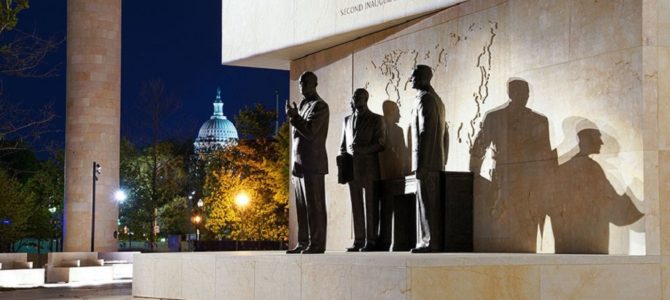
Perhaps the kindest observation one could make regarding the new, Frank Gehry-designed Dwight D. Eisenhower Memorial, which just opened here in the nation’s capital this past Friday, is that at least it doesn’t look like a Frank Gehry. After many years of controversy, finger-pointing, and editorializing about the project, the end result is dull. Yet the fact that it fails to inspire either admiration or ire raises the question of what was the point in having North America’s most prominent “starchitect” involved in the project.
Fortunately, the capital skyline has not been marred by one of Gehry’s now-clichéd bits of crumpled tinfoil, such as the Museum of Pop Culture in Seattle and the Walt Disney Concert Hall in Los Angeles. Yet while bits and pieces of things in this monumental plaza might be more or less acceptable, alongside others that are sloppy and ill-considered, there doesn’t appear to be anything that one could point to and say, “Ah—this must be by Frank Gehry.” Indeed, as the friend who visited the memorial with me remarked: “This looks like it was done by a committee.”

To begin with, there is the question of where exactly one is supposed to enter the space, which occupies a four-acre site directly in front of the Department of Education, across Independence Avenue from the Smithsonian National Air and Space Museum. One might reasonably assume that the tour should begin at the visitors’ center, but this structure is placed at the conclusion of the timeline evoked by the various sculptural and architectural elements that make up the memorial, rather than at the earliest historical point.
The Truck Stop Version of Ike Eisenhower
In chronological terms, the earliest portion of the memorial is a bronze statue of a young Eisenhower by Sergey Eylanbekov. Of the major sculptural elements that comprise the monument, it is probably the most appealing, comparatively speaking. On my visit, it was already becoming a magnet for selfies, since it sits on a low plinth that is easily accessible for those who want to touch or even embrace it.
In this first section, Ike is depicted as a farm boy dressed in overalls and seated on the ground. If viewed from a certain angle, it looks a bit like something Renoir might have cooked up in collaboration with Modigliani after attending an El Greco exhibition. From another, the effect is that of a garden sculpture acquired from an interstate truck stop selling “country” items made in China.
Across from the statue is a wall of text, handsomely carved by Nicholas Benson, with the first of several lengthy quotes from Eisenhower speeches that appear at various points around the memorial. In this case, the quote is from Ike’s 1945 homecoming speech in Abilene, Kansas. In it, he referred to having once been a “barefoot boy,” a reference which at one time was going to result in a large bronze of an unshod Ike. In the end, the figure wears shoes, although one gets the sense that the famous “disappearing toe” of Arnolfo di Cambio’s statue of St. Peter in the Vatican is about to be replicated yet again.
How Soviets Might Have Imagined Ike
Moving along to the two main sculptural groups located at the center of the monumental complex, one is presented with a juxtaposition of Eisenhower’s roles as general and president, thereby contrasting concepts of war and peace. Ike is shown addressing the troops before D-Day on the right, and leading what is presumably a White House cabinet meeting on the left. There is a whiff of Midcentury Modern about these sculptures, but of the downmarket Soviet Realist variety, like a monument to Nikita Khrushchev put up in a regional capital somewhere in the Urals.
In the “War” scene, Eisenhower offers a clenched fist, while in the “Peace” scene he raises an open hand—and what hammy hands they are. One of the hallmarks of a great artist is the ability to portray the human hand in a convincing way. In this case, all the figures’ hands are so grossly disproportionate to the rest of their bodies that they unintentionally evoke Jerry Seinfeld and his girlfriend with “man hands.”
The contrasting sculptural groups stand on separate platforms surmounted by massive, off-center blocks bearing more Eisenhower quotations. Over the “War” group is an excerpt from his D-Day address to the troops: “The tide has turned! The free men of the world are marching together to victory!” Meanwhile, on the “Peace” side is a portion from his second inaugural address in 1957: “We look upon this shaken Earth, and we declare our firm and fixed purpose—the building of a peace with justice in a world where moral law prevails.”
No Structural Opportunity to Ponder Ike’s Words
If one walks behind each of these two structures, there are lengthier excerpts from three of Eisenhower’s major speeches. On the “War” pylon is part of his Guildhall speech of 1945, and on the “Peace” pylon one sees text from his first inaugural address and from his 1961 farewell speech. These longer passages provide a greater sense of the man, his values, and his concerns during a period of shifting conflict from World War to Cold War.
Thanks to a retaining wall supporting a raised platform with a view of nothing in particular, the only way one can read the text of these speeches is by cramming into a sort of wedge-shaped space and craning one’s neck. While the memorial site is literally festooned with surprisingly comfortable stone benches along its central pathway, these are neither in front of nor in close proximity to any of the texts. This decision seems rather a thoughtless one, since it denies the visitor the opportunity to sit and ponder Eisenhower’s words.
Other elements scattered about the memorial are more difficult to understand. The two freestanding columns at either end of the site have very nice stonework, and some discreet metal ornamentation at eye level. Yet if in principle they were meant to evoke European ruins, in person they look more like fancy smokestacks.

A long row of similar column-cum-smokestacks supports a colossal screen by metal tapestry artist Tomas Osinski that runs almost the entire length of the site, presumably obscuring the view of Independence Avenue and The Mall for those Department of Education workers unfortunate enough to work on that side of their headquarters.
This part of the installation is meant to represent the cliffs of Normandy, as much as what appears to be construction tarp covered in graffiti can look like Normandy, (my companion thought it was some sort of camouflage netting.) Since apparently quite a few people like having graffiti on public buildings these days, perhaps this is just a way to embrace that trend.
Maybe Gehry’s Not Really Proud of This One
After “Not-Actually-Barefoot Boy” Ike, followed by General Ike and President Ike, one might reasonably expect a fourth sculpture to round out the ensemble. One could imagine “Golfing Ike” or “Fishing Ike,” for example, or even “Grandpa Ike” surrounded by his grandchildren back on the farm, as a kind of 20th century Cincinnatus figure. Instead, one finds the aforementioned visitors’ center.
This structure turned out to be my favorite element of the memorial, although it’s a bit curious that benches have been placed directly opposite the various entrances to the bathrooms while, as stated earlier, no benches are located around either the sculptures or inscriptions. The visitors’ center looks like something Richard Estes might choose to paint, a bit like a midcentury post office, with its glass and stainless steel vestibule echoing those of the 1961 LBJ building just behind it.
Interestingly, this small building is the only place the name “Gehry” appears on the entire project, and even then it’s as part of “Gehry and Partners,” buried at the bottom of a list of many other names. Meanwhile, near the main sculptural groups, a carved panel lists the chairman and vice chairman of the memorial commission, as well as the artists who executed the sculptures, graffiti curtain, and inscriptions, but Gehry’s name is conspicuous by its absence. This seems decidedly curious for an architect not known for modesty, particularly one who tried unsuccessfully for years to get something of his built in Washington.
The Sculptural Equivalent of a Blue Checkmark
After the rest of the world suddenly became aware, more than two decades ago, of the fact that there is a large human settlement in Spain called Bilbao, a Gehry structure became the ultimate architectural fashion accessory. This resulted in a spate of Gehry or Gehry-like building projects across the globe, much as the Coliseum led Ancient Roman provincials to commission ever-larger and more lavishly appointed arenas for the killing of other Roman provincials as a hallmark of civic virtue. Yet as with all fads in architectural design, eventually such trends become little more than repetitive kitsch.
While Washington is very fortunate to have escaped this fate, in visiting the Eisenhower Memorial one gets the sense that, perhaps as a result of frustration with the criticism he experienced during the long gestation of this commission, Gehry simply turned in his science fair diorama as-is. The architecture is neither Gehry-ish enough to be recognizable as one of his works, nor un-Gehry enough to be in good taste. It’s as if the city has finally achieved the equivalent of a blue checkmark on Twitter, but well past the point where such things had any real significance.

So I end where I began this article, wondering what was the point of having a passé provocateur design the Eisenhower Memorial in the first place. It would have been simpler, more dignified, and far less costly to simply commission a capable sculptor to execute a statue, place it on a restrained, dignified plinth in a landscaped setting, and leave it at that. Such a result would have been more in keeping with the character of the man, as revealed in the text of a speech he never got to deliver.
On the eve of D-Day, Eisenhower wrote a brief address he planned to give in case the Normandy invasion failed. Fortunately, he never had to deliver it, but the hand-written draft survived, and is now preserved in his presidential library.
Perhaps the most striking, and most telling, part of the speech reads, “If any blame or fault attaches to the attempt, it is mine alone.” One wonders whether those responsible for such a mediocre mishmash of a memorial would be capable of making a similar statement.









